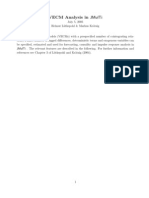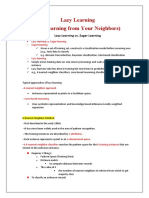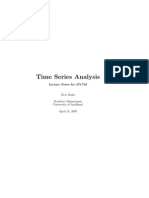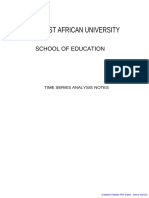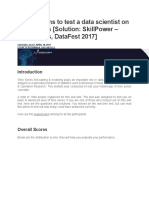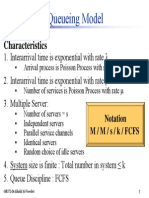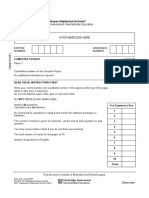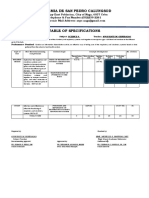Data Analysis Course
Time Series Analysis & Forecasting
Venkat Reddy
Contents
• ARIMA
• Stationarity
• AR process
• MA process
Venkat Reddy
Data Analysis Course
• Main steps in ARIMA
• Forecasting using ARIMA model
• Goodness of fit
2
Drawbacks of the use of traditional
models
• There is no systematic approach for the identification and
selection of an appropriate model, and therefore, the
identification process is mainly trial-and-error
• There is difficulty in verifying the validity of the model
• Most traditional methods were developed from intuitive and
Venkat Reddy
Data Analysis Course
practical considerations rather than from a statistical foundation
3
ARIMA Models
• Autoregressive Integrated Moving-average
• A “stochastic” modeling approach that can be used to
calculate the probability of a future value lying between two
specified limits
Venkat Reddy
Data Analysis Course
4
AR & MA Models
• Autoregressive AR process:
• Series current values depend on its own previous values
• AR(p) - Current values depend on its own p-previous values
• P is the order of AR process
• Moving average MA process:
Venkat Reddy
Data Analysis Course
• The current deviation from mean depends on previous deviations
• MA(q) - The current deviation from mean depends on q- previous
deviations
• q is the order of MA process
• Autoregressive Moving average ARMA process
5
AR Process
Venkat Reddy
Data Analysis Course
AR(1) yt = a1* yt-1 6
AR(2) yt = a1* yt-1 +a2* yt-2
AR(3) yt = a1* yt-1 + a2* yt-2 +a3* yt-2
MA Process
Venkat Reddy
Data Analysis Course
MA(1) εt = b1*εt-1
MA(2) εt = b1*εt-1 + b2*εt-2
MA(3) εt = b1*εt-1 + b2*εt-2+ b3*εt-3 7
ARIMA Models
• Autoregressive (AR) process:
• Series current values depend on its own previous values
• Moving average (MA) process:
• The current deviation from mean depends on previous deviations
• Autoregressive Moving average (ARMA) process
Venkat Reddy
Data Analysis Course
• Autoregressive Integrated Moving average
(ARIMA)process.
• ARIMA is also known as Box-Jenkins approach. It is popular because of its
generality;
• It can handle any series, with or without seasonal elements, and it has well-
documented computer programs
8
ARIMA Model
→ AR filter → Integration filter → MA filter → εt
(long term) (stochastic trend) (short term) (white noise error)
ARIMA (2,0,1) yt = a1yt-1 + a2yt-2 + b1εt-1
Venkat Reddy
Data Analysis Course
ARIMA (3,0,1) yt = a1yt-1 + a2yt-2 + a3yt-3 + b1εt-1
ARIMA (1,1,0) Δyt = a1 Δ yt-1 + εt , where Δyt = yt - yt-1
ARIMA (2,1,0) Δyt = a1 Δ yt-1 + a2Δ yt-2 + εt where Δyt = yt - yt-1
To build a time series model issuing ARIMA, we need to study the time
series and identify p,d,q
9
ARIMA equations
• ARIMA(1,0,0)
• yt = a1yt-1 + εt
• ARIMA(2,0,0)
• yt = a1yt-1 + a2yt-2 + εt
Venkat Reddy
Data Analysis Course
• ARIMA (2,1,1)
• Δyt = a1 Δ yt-1 + a2Δ yt-2 + b1εt-1 where Δyt = yt - yt-1
10
Overall Time series Analysis &
Forecasting Process
• Prepare the data for model building- Make it stationary
• Identify the model type
• Estimate the parameters
• Forecast the future values
Venkat Reddy
Data Analysis Course
11
ARIMA (p,d,q) modeling
To build a time series model issuing ARIMA, we need to study the time
series and identify p,d,q
• Ensuring Stationarity
• Determine the appropriate values of d
• Identification:
• Determine the appropriate values of p & q using the ACF, PACF, and
Venkat Reddy
Data Analysis Course
unit root tests
• p is the AR order, d is the integration order, q is the MA order
• Estimation :
• Estimate an ARIMA model using values of p, d, & q you think are
appropriate.
• Diagnostic checking:
• Check residuals of estimated ARIMA model(s) to see if they are white
noise; pick best model with well behaved residuals.
• Forecasting:
• Produce out of sample forecasts or set aside last few data points for 12
in-sample forecasting.
The Box-Jenkins Approach
1.Differencing the 3.Estimate the
series to achieve 2.Identify the model parameters of the
stationary model
Venkat Reddy
Data Analysis Course
Diagnostic checking.
No Is the model
adequate?
13
4. Use Model for forecasting Yes
Step-1 : Stationarity
Data Analysis Course
14
Venkat Reddy
Some non stationary series
1 2
Venkat Reddy
Data Analysis Course
3 4
15
Stationarity
• In order to model a time series with the Box-Jenkins approach,
the series has to be stationary
• In practical terms, the series is stationary if tends to wonder
more or less uniformly about some fixed level
Venkat Reddy
Data Analysis Course
• In statistical terms, a stationary process is assumed to be in a
particular state of statistical equilibrium, i.e., p(xt) is the same
for all t
• In particular, if zt is a stationary process, then the first
d
difference zt = zt - zt-1and higher differences zt are
16
stationary
Testing Stationarity
• Dickey-Fuller test
• P value has to be less than 0.05 or 5%
• If p value is greater than 0.05 or 5%, you accept the null hypothesis,
you conclude that the time series has a unit root.
• In that case, you should first difference the series before proceeding
with analysis.
Venkat Reddy
Data Analysis Course
• What DF test ?
• Imagine a series where a fraction of the current value is depending
on a fraction of previous value of the series.
• DF builds a regression line between fraction of the current value Δyt
and fraction of previous value δyt-1
• The usual t-statistic is not valid, thus D-F developed appropriate
critical values. If P value of DF test is <5% then the series is
stationary 17
Demo: Testing Stationarity
• Sales_1 data
Stochastic trend: Inexplicable changes in direction
Venkat Reddy
Data Analysis Course
18
Demo: Testing Stationarity
Augmented Dickey-Fuller Unit Root Tests
Type Lags Rho Pr < Rho Tau Pr < Tau F Pr > F
Zero 0 0.3251 0.7547 0.74 0.8695
Mean
1 0.3768 0.7678 1.26 0.9435
Venkat Reddy
Data Analysis Course
2 0.3262 0.7539 1.05 0.9180
Single 0 -6.9175 0.2432 -1.77 0.3858 2.05 0.5618
Mean
1 -3.5970 0.5662 -1.06 0.7163 1.52 0.6913
2 -3.7030 0.5522 -0.88 0.7783 1.02 0.8116
Trend 0 -11.8936 0.2428 -2.50 0.3250 3.16 0.5624
1 -7.1620 0.6017 -1.60 0.7658 1.34 0.9063
2 -9.0903 0.4290 -1.53 0.7920 1.35 0.9041
19
Achieving Stationarity
• Differencing : Transformation of the series to a new time series
where the values are the differences between consecutive values
• Procedure may be applied consecutively more than once, giving rise
to the "first differences", "second differences", etc.
• Regular differencing (RD)
Venkat Reddy
Data Analysis Course
(1st order) xt = xt – xt-1
(2nd order) 2x
t = ( xt - xt-1 )=xt – 2xt-1 + xt-2
• It is unlikely that more than two regular differencing would ever be
needed
• Sometimes regular differencing by itself is not sufficient and prior 20
transformation is also needed
Differentiation
Actual Series
Venkat Reddy
Data Analysis Course
Series After
Differentiation
21
Demo: Achieving Stationarity
data lagsales_1;
set sales_1;
sales1=sales-lag1(sales);
run;
Augmented Dickey-Fuller Unit Root Tests
Type Lags Rho Pr < Rho Tau Pr < Tau F Pr > F
Venkat Reddy
Data Analysis Course
Zero 0 -37.7155 <.0001 -7.46 <.0001
Mean
1 -32.4406 <.0001 -3.93 0.0003
2 -19.3900 0.0006 -2.38 0.0191
Single 0 -38.9718 <.0001 -7.71 0.0002 29.70 0.0010
Mean
1 -37.3049 <.0001 -4.10 0.0036 8.43 0.0010
2 -25.6253 0.0002 -2.63 0.0992 3.50 0.2081
Trend 0 -39.0703 <.0001 -7.58 0.0001 28.72 0.0010
1 -37.9046 <.0001 -4.08 0.0180 8.35 0.0163 22
2 -25.7179 0.0023 -2.59 0.2875 3.37 0.5234
Demo: Achieving Stationarity
Data Analysis Course
23
Venkat Reddy
Achieving Stationarity-Other methods
• Is the trend stochastic or deterministic?
• If stochastic (inexplicable changes in direction): use differencing
• If deterministic(plausible physical explanation for a trend or
seasonal cycle) : use regression
• Check if there is variance that changes with time
Venkat Reddy
Data Analysis Course
• YES : make variance constant with log or square root
transformation
• Remove the trend in mean with:
• 1st/2nd order differencing
• Smoothing and differencing (seasonality)
• If there is seasonality in the data:
• Moving average and differencing
• Smoothing 24
Step2 : Identification
Data Analysis Course
25
Venkat Reddy
Identification of orders p and q
• Identification starts with d
• ARIMA(p,d,q)
• What is Integration here?
• First we need to make the time series stationary
Venkat Reddy
Data Analysis Course
• We need to learn about ACF & PACF to identify p,q
• Once we are working with a stationary time series, we can
examine the ACF and PACF to help identify the proper number
of lagged y (AR) terms and ε (MA) terms.
26
Autocorrelation Function (ACF)
• Autocorrelation is a correlation coefficient. However, instead
of correlation between two different variables, the correlation
is between two values of the same variable at times Xi and
Xi+k.
• Correlation with lag-1, lag2, lag3 etc.,
Venkat Reddy
Data Analysis Course
• The ACF represents the degree of persistence over respective
lags of a variable.
ρk = γk / γ0 = covariance at lag k/ variance
ρk = E[(yt – μ)(yt-k – μ)]2
E[(yt – μ)2]
ACF (0) = 1, ACF (k) = ACF (-k)
27
ACF Graph
1.00
0.50
Venkat Reddy
Data Analysis Course
0.00
-0.50
0 10 20 30 40
Lag
Bartlett's formula for MA(q) 95% confidence bands
28
Partial Autocorrelation Function (PACF)
• The exclusive correlation coefficient
• Partial regression coefficient - The lag k partial autocorrelation is
the partial regression coefficient, θkk in the kth order auto regression
• In general, the "partial" correlation between two variables is the
amount of correlation between them which is not explained by their
Venkat Reddy
Data Analysis Course
mutual correlations with a specified set of other variables.
• For example, if we are regressing a variable Y on other variables X1,
X2, and X3, the partial correlation between Y and X3 is the amount
of correlation between Y and X3 that is not explained by their
common correlations with X1 and X2.
• yt = θk1yt-1 + θk2yt-2 + …+ θkkyt-k + εt
• Partial correlation measures the degree of association between
two random variables, with the effect of a set of controlling random 29
variables removed.
PACF Graph
1.00
0.50
Venkat Reddy
Data Analysis Course
0.00
-0.50
0 10 20 30 40
Lag
95% Confidence bands [se = 1/sqrt(n)]
30
Identification of AR Processes & its order -p
• For AR models, the ACF will dampen exponentially
• The PACF will identify the order of the AR model:
• The AR(1) model (yt = a1yt-1 + εt) would have one significant spike
at lag 1 on the PACF.
• The AR(3) model (yt = a1yt-1+a2yt-2+a3yt-3+εt) would have
significant spikes on the PACF at lags 1, 2, & 3.
Venkat Reddy
Data Analysis Course
31
AR(1) model
yt = 0.8yt-1 + εt
Data Analysis Course
32
Venkat Reddy
AR(1) model
yt = 0.77yt-1 + εt
Data Analysis Course
33
Venkat Reddy
AR(1) model
yt = 0.95yt-1 + εt
Data Analysis Course
34
Venkat Reddy
AR(2) model
yt = 0.44yt-1 + 0.4yt-2 + εt
Venkat Reddy
Data Analysis Course
35
AR(2) model
yt = 0.5yt-1 + 0.2yt-2 + εt
Venkat Reddy
Data Analysis Course
36
AR(3) model
yt = 0.3yt-1 + 0.3yt-2 + 0.1yt-3 +εt
Venkat Reddy
Data Analysis Course
37
Once again
Data Analysis Course
38
Venkat Reddy
Identification of MA Processes & its order - q
• Recall that a MA(q) can be represented as an AR(∞), thus we expect the
opposite patterns for MA processes.
• The PACF will dampen exponentially.
• The ACF will be used to identify the order of the MA process.
• MA(1) (yt = εt + b1 εt-1) has one significant spike in the ACF at lag 1.
• MA (3) (yt = εt + b1 εt-1 + b2 εt-2 + b3 εt-3) has three significant spikes in the
Venkat Reddy
Data Analysis Course
ACF at lags 1, 2, & 3.
39
MA(1)
yt = -0.9εt-1
Data Analysis Course
40
Venkat Reddy
MA(1)
yt = 0.7εt-1
Data Analysis Course
41
Venkat Reddy
MA(1)
yt = 0.99εt-1
Data Analysis Course
42
Venkat Reddy
MA(2)
yt = 0.5εt-1 + 0.5εt-2
Data Analysis Course
43
Venkat Reddy
MA(2)
yt = 0.8εt-1 + 0.9εt-2
Data Analysis Course
44
Venkat Reddy
MA(3)
yt = 0.8εt-1 + 0.9εt-2 + 0.6εt-3
Venkat Reddy
Data Analysis Course
45
Once again
Data Analysis Course
46
Venkat Reddy
ARMA(1,1)
yt = 0.6yt-1 + 0.8εt-1
Venkat Reddy
Data Analysis Course
47
ARMA(1,1)
yt = 0.78yt-1 + 0.9εt-1
Venkat Reddy
Data Analysis Course
48
ARIMA(2,1)
yt = 0.4yt-1 + 0.3yt-2 + 0.9εt-1
Venkat Reddy
Data Analysis Course
49
ARMA(1,2)
yt = 0.8yt-1 + 0.4εt-1 + 0.55εt-2
Venkat Reddy
Data Analysis Course
50
ARMA Model Identification
Data Analysis Course
51
Venkat Reddy
Demo1: Identification of the model
proc arima data= chem_readings plots=all;
identify var=reading scan esacf center ;
run;
Venkat Reddy
Data Analysis Course
52
• ACF is dampening, PCF graph cuts off. - Perfect example of an AR process
Demo: Identification of the model
PACF cuts off after lag 2
1. d = 0, p =2, q= 0
Venkat Reddy
Data Analysis Course
SAS ARMA(p+d,q) Tentative Order Selection Tests
SCAN ESACF
p+d q p+d q
2 0 2 3
1 5 4 4
5 3
53
yt = a1yt-1 + a2yt-2 + εt
LAB: Identification of model
• Download web views data
• Use sgplot to create a trend chart
• What does ACF & PACF graphs say?
• Identify the model using below table
• Write the model equation
Venkat Reddy
Data Analysis Course
54
Step3 : Estimation
Data Analysis Course
55
Venkat Reddy
Parameter Estimate
• We already know the model equation. AR(1,0,0) or AR(2,1,0)
or ARIMA(2,1,1)
• We need to estimate the coefficients using Least squares.
Minimizing the sum of squares of deviations
Venkat Reddy
Data Analysis Course
56
Demo1: Parameter Estimation
• Chemical reading data
proc arima data=chem_readings;
identify var=reading scan esacf center;
estimate p=2 q=0 noint method=ml;
Venkat Reddy
Data Analysis Course
run;
Maximum Likelihood Estimation
Parameter Estimate Standard t Value Approx Lag
Error Pr > |t|
AR1,1 0.42444 0.06928 6.13 <.0001 1
AR1,2 0.25315 0.06928 3.65 0.0003 2
57
yt = 0. 424yt-1 + 0.2532yt-2 + εt
Lab: Parameter Estimation
• Estimate the parameters for webview data
Venkat Reddy
Data Analysis Course
58
Step4 : Forecasting
Data Analysis Course
59
Venkat Reddy
Forecasting
• Now the model is ready
• We simply need to use this model for forecasting
proc arima data=chem_readings;
identify var=reading scan esacf center;
Venkat Reddy
Data Analysis Course
estimate p=2 q=0 noint method=ml;
forecast lead=4 ;
run;
Forecasts for variable Reading
Obs Forecast Std Error 95% Confidence Limits
198 17.2405 0.3178 16.6178 17.8633
199 17.2235 0.3452 16.5469 17.9000
200 17.1759 0.3716 16.4475 17.9043 60
201 17.1514 0.3830 16.4007 17.9020
LAB: Forecasting using ARIMA
• Forecast the number of sunspots for next three hours
Venkat Reddy
Data Analysis Course
61
Validation: How good is my model?
• Does our model really give an adequate description of the
data
• Two criteria to check the goodness of fit
• Akaike information criterion (AIC)
Venkat Reddy
Data Analysis Course
• Schwartz Bayesiancriterion (SBC)/Bayesian information criterion
(BIC).
• These two measures are useful in comparing two models.
• The smaller the AIC & SBC the better the model
62
Goodness of fit
• Remember… Residual analysis and Mean deviation, Mean
Absolute Deviation and Root Mean Square errors?
• Four common techniques are the:
n Yi Ŷ i
Venkat Reddy
Data Analysis Course
• Mean absolute deviation, MAD =
i 1 n
• Mean absolute percent error 100 n Yi Ŷ i
MAPE =
n i 1 Yi
2
n
Yi Ŷ i
• Mean square error, MSE =
i 1 n
• Root mean square error. RMSE MSE 63
Lab: Overall Steps on sunspot
example
• Import the time series data
• Prepare the data for model building- Make it stationary
• Identify the model type
• Estimate the parameters
Venkat Reddy
Data Analysis Course
• Forecast the future values
64
Thank you
Data Analysis Course
65
Venkat Reddy

